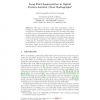Free Online Productivity Tools
i2Speak
i2Symbol
i2OCR
iTex2Img
iWeb2Print
iWeb2Shot
i2Type
iPdf2Split
iPdf2Merge
i2Bopomofo
i2Arabic
i2Style
i2Image
i2PDF
iLatex2Rtf
Sci2ools
ICAPR
2005
Springer
2005
Springer
Lung Field Segmentation in Digital Postero-Anterior Chest Radiographs
This paper describes a lung field segmentation method, working on digital Postero-Anterior chest radiographs. The lung border is detected by integrating the results obtained by two simple and classical edge detectors, thus exploiting their complementary advantages. The method makes no assumption regarding the chest position, size and orientation; it has been tested on a non-trivial set of real life cases, composed of 412 radiographs belonging to two different databases. The obtained results and the comparison with more complicate techniques presented in the literature, prove the robustness of the algorithm and demonstrate that rather simple and general methods, properly combined to fit the requirements of a specific application, can provide better results.
Classical Edge Detectors | ICAPR 2005 | Lung field Segmentation | Postero-Anterior Chest Radiographs |
| Added | 27 Jun 2010 |
| Updated | 27 Jun 2010 |
| Type | Conference |
| Year | 2005 |
| Where | ICAPR |
| Authors | Paola Campadelli, Elena Casiraghi |
Comments (0)

